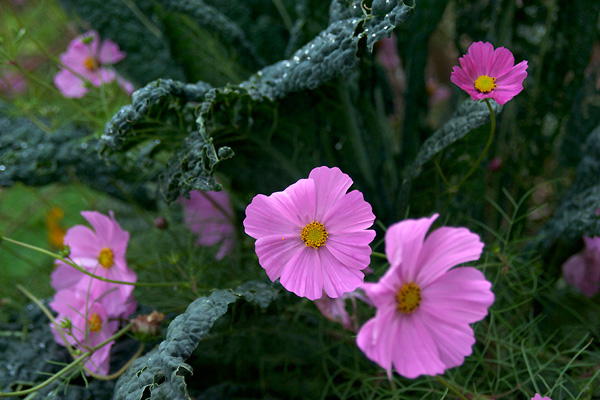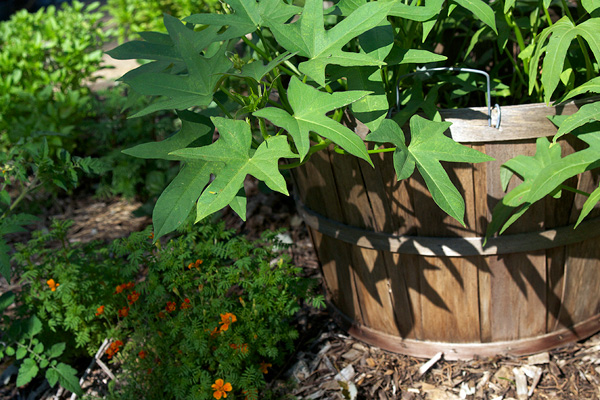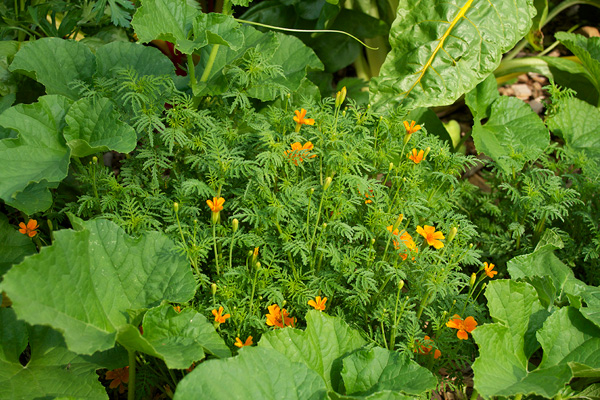Grow Veggies in Your Flower Garden? Absolutely!
- Published: March 11, 2013
- By: Cristina Santiestevan
Breaking the rules by mixing edibles with ornamentals makes for happy horticulture.

These "Matt's Wild Cherry" tomatoes are interspersed with fall-blooming aster for a gorgeous color combination. All images in this post: Cristina Santiestevan
In my garden, kale dances with cosmos, sweet potatoes mingle with marigolds, and bush beans party with coneflowers and black-eyed Susans. That’s right. Vegetables have invaded my flower garden.
The rules say flowers deserve the front yard spotlight while veggies should be hidden in the backyard. But some rules are made to be broken. That one, for example.
I started growing veggies with my front yard flowers because I had to — the backyard is too shady. Now, I’m hooked. Once you mix your edibles and ornamentals, I’m betting you’ll be hooked too.
The combination attracts lots of bees, butterflies, and other pollinators, which helps ensure healthy edibles. It’s also a great solution if you don’t have a lot of space for both a veggie and flower garden. Plus, it’s fun!
There’s nothing special to getting started. Really. If you already have a flower bed or a foundation planting, go ahead and add some veggies to the mix. Just remember, your vegetables’ needs don’t change just because they’re growing amongst flowers. Tomatoes will still demand space and sunlight, and lettuces will still want protection from the full force of summer’s heat.
For me, the biggest challenge was giving up the tidiness of an orderly vegetable garden and embracing the haphazard beauty of edibles scattered among ornamentals.
Keep these tips in mind when selecting veggies for your flower beds:



Sometimes, looks matter a great deal. Formal vegetable gardens are a front yard no-no according to my HOA, but my blend of veggies and flowers has received nothing but compliments from neighbors. Even if you aren’t regulated by an HOA, it’s still worth keeping aesthetics in mind. It’s just the neighborly thing to do.
Did you know that including herbs and veggies is a tradition of beautiful cottage gardens that goes back to the mid-1800s?
Cristina Santiestevan
The rules say flowers deserve the front yard spotlight while veggies should be hidden in the backyard. But some rules are made to be broken. That one, for example.
I started growing veggies with my front yard flowers because I had to — the backyard is too shady. Now, I’m hooked. Once you mix your edibles and ornamentals, I’m betting you’ll be hooked too.
The combination attracts lots of bees, butterflies, and other pollinators, which helps ensure healthy edibles. It’s also a great solution if you don’t have a lot of space for both a veggie and flower garden. Plus, it’s fun!
There’s nothing special to getting started. Really. If you already have a flower bed or a foundation planting, go ahead and add some veggies to the mix. Just remember, your vegetables’ needs don’t change just because they’re growing amongst flowers. Tomatoes will still demand space and sunlight, and lettuces will still want protection from the full force of summer’s heat.
For me, the biggest challenge was giving up the tidiness of an orderly vegetable garden and embracing the haphazard beauty of edibles scattered among ornamentals.
Keep these tips in mind when selecting veggies for your flower beds:
- Some veggies are easy to blend with flowers — lacinato kale looks fantastic with pink cosmos, for example — while others tend to overwhelm. I wouldn’t suggest planting a massive pumpkin vine in a petite flower bed.

- Mix things up with containers. I’ve had great success growing sweet potatoes in inexpensive bushel baskets.

- Be prepared to fill gaps created when you harvest your home-grown edibles. Bush beans are my favorite gap-filling vegetable because they grow fast, look fantastic, and taste even better.
- Blend contrasting shapes, colors, and sizes. Bold cantaloupe vines provide an excellent backdrop for lacy marigold leaves and flowers, for example.

- Experiment. On a whim, I let some ‘Matt’s Wild Cherry’ tomatoes sprawl through my fall-blooming asters. The results were spectacular.
- Winter can be a challenge. If you live in a milder region, you may be able to grow edibles year-round. Northern gardeners, however, must plan for cold weather. Try adding a few winter-interest plants to your garden. My red-twig dogwood is a star in the snow, for example.
Sometimes, looks matter a great deal. Formal vegetable gardens are a front yard no-no according to my HOA, but my blend of veggies and flowers has received nothing but compliments from neighbors. Even if you aren’t regulated by an HOA, it’s still worth keeping aesthetics in mind. It’s just the neighborly thing to do.
Did you know that including herbs and veggies is a tradition of beautiful cottage gardens that goes back to the mid-1800s?
Cristina Santiestevan
Read more: http://www.houselogic.com/blog/gardens/vegetable-flower-garden/#ixzz2O7yxgzIQ
No comments:
Post a Comment